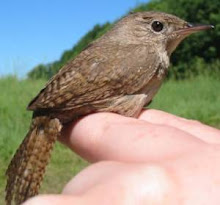
Hi! I've been very busy in the field. I will try to be more on top things. Rather than cram a lot of information, I'm just going to be back logged in entries for a bit. Let's return to the nest building basics.

The males return first and begin to build the base of the nest. They add lots of sticks slowly building up to whatever height they choose. There is no particular height requirement.
The sticks are placed randomly on top of each to create the base or they start to create a circular pattern (above). In this picture to the left , the sticks are stacked about 1 inch high from the bottom of the nest box. From my experience, they tend to build nests from 1-7 inches high (the highest is right at the opening of the box.
Males eventually will create a cup shape at the top of the nest when they have almost reached their desired height. The picture below is of a nest about 4 inches tall. Then the male has completed his portion of the nest building and await to be paired with a female.









